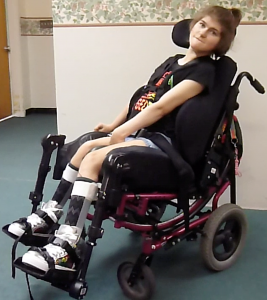Michelle L. Lange, OTR/L, ABDA, ATP/SMS
Dynamic Seating is movement which occurs within the seat and/or wheelchair frame in response to force from the client. Dynamic components absorb force which in turn assists the client back to a starting position. Dynamic Seating is frequently used to prevent equipment breakage, prevent client injury, diffuse extensor tone, and provide movement. For people with cerebral palsy who use a wheelchair, Dynamic Seating is a great option for many reasons.

Amber has a Cerebral Palsy diagnosis and benefits greatly from Dynamic Seating.
People with cerebral palsy often have increased muscle tone and uncontrolled movement patterns. This particular type of muscle tone tends to increase when encountering a static, unyielding surface – such as a wheelchair back or footrest which doesn’t move. Dynamic Seating moves in response to the forces which extensor tone creates; moving and diffusing this increased muscle tone. In 2015, research from Phadke, et. al demonstrated that movement reduces spasticity.
Tone reduction through Dynamic Seating has some key benefits:
- Decreased pain / increased comfort. This is the number one client and caregiver goal for wheelchair seating.
- Decreased energy consumption. This force diffusion literally reduces calorie consumption. I have worked with clients who gained much-needed weight after use of Dynamic Seating.
- Decreased client injury. When extreme forces are not diffused, the forces are experienced primarily in the joints. This can lead to pain and even injury. People with cerebral palsy tend to develop conditions such as arthritis at younger ages than the general population (Peterson, et al., 2015) – arthritis can develop when a joint is submitted to stress.
- Decreased equipment breakage. These extreme forces are not just hard on the body, but also on equipment. Many people with cerebral palsy routinely move seating components out of alignment (i.e. a head support) or actually break items on the wheelchair frame. Diffusing these forces can protect the equipment from further breakage.
- Increased client function. During extension, most of the client’s movements are dominated by this ‘pattern of movement.’ By diffusing these forces, the client has the opportunity to move outside of these patterns, providing more functional isolated movements.
Amber loves her Dynamic Seating!
The movement provided by Dynamic Seating responds not only to extensor forces, but also to uncontrolled movement. When the client exhibits sudden, large movements, the Dynamic components will respond, absorbing the force of these movements and, again, protecting both the client and the frame. Movement, in addition to reducing muscle tone, provides active range of motion at the joints which also increases comfort.
If you have cerebral palsy or are a caregiver or provider for someone with this diagnosis, consider the benefits Dynamic Seating could offer as a part of the wheelchair solution. If you have any questions, please ask in the Comments section below!
References:
- Phadke, C. P., Ismail, F., & Boulias, C. (2015). Current challenges to clinical assessment of spasticity. International Journal of Neurology Research, 1(1), 1-4.
- Peterson, M. D., Ryan, J. M., Hurvitz, E. A., & Mahmoudi, E. (2015). Chronic conditions in adults with cerebral palsy. Jama, 314(21), 2303-2305.
** This post was originally published on https://www.seatingdynamics.com/2019/08/20/dynamic-seating-for-cerebral-palsy-diagnoses/

